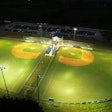![[Rendering courtesy of PLAE]](https://img.athleticbusiness.com/files/base/abmedia/all/image/2021/04/ab.outdoor521_feat.png?auto=format%2Ccompress&q=70&w=400)
Even prior to the pandemic, Florida Gulf Coast University director of campus recreation Amy Swingle had her eye on an outdoor space to augment the campus's new Student Recreation and Wellness Center, which opened in January 2020. "A lot of our stuff was outdoors already, and a lot of the students who come down here don't mind working out outdoors," Swingle says.
Once the pandemic hit, the notion of outdoor fitness began to look even better. FGCU's roughly 20,000-square-foot outdoor fitness space is expected to open this summer. "We always had this on our radar, and we always wanted to do this, but COVID-19 and our response to that made it more feasible in some of the administration's eyes," says Swingle, "because all of a sudden they saw the benefits of working out outdoors."
Outdoor spaces specifically designed for fitness were popping up on college campuses even prior to the pandemic, according to Erik Kocher, principal with St. Louis-based Hastings+Chivetta Architects. "We seem to have been doing them for 20 years, but the early ones tended to be outdoor social spaces that were adjacent to the rec center," he says. "But we've been doing more outdoor amenity spaces."
As we begin to put the pandemic in the rearview mirror, the trend for programmed outdoor fitness spaces is likely to remain. Here's a look at what's driving the trend, as well as some key considerations.
Key considerations in planning your own outdoor fitness spaceOutdoor fitness spaces aren't as straightforward as simply arranging equipment in a rec center courtyard. "If you're going to do one, you really need to plan it," says Hastings+Chivetta principal Erik Kocher. Here are a few things Kocher recommends to keep in mind when planning your own outdoor space. 1. Storage. Failure to plan for storage can create headaches when the facility is operational, according to Kocher. "You think about lugging stuff out, lugging stuff back in," he says. "The more storage you can have directly off of that space is what we think works." 2. Canopies/shade structures. Says Kocher, "The 6 a.m. sunrise yoga class might be fine, but if you're going to have something at 3 o'clock in the afternoon, depending on the orientation of it, the space may be too hot to use for most of the school year, depending on where you are." 3. Flexibility. Depending on the unique requirements of an owner, an outdoor space can be used for a multitude of functions. Planning for such a space may necessitate the inclusion of additional amenities, such as lighting, sound systems and/or additional storage, Kocher says. |
Flexible programming
The outdoor facility at FGCU will include such amenities as turf track lanes, jumping platforms and heavy-duty rigs with a monkey bar lane, pull-up/suspension-training stations, medicine ball stations, battle rope stations, plyo platforms and a BeaverFit locker system. When taken together, these amenities allow for a wide variety of programming options.
"If they want to do an outdoor yoga class, there is space to do that. If they want to do an outdoor strength training class, there's a space to do that, as well. If they just want to do an outdoor HIIT-type training class, there's all kinds of space to do that," says Jet Thompson, vice president of PLAE Outdoors, which is working with FGCU on the project. "There are going to be times when it's utilized for classes, and there are going to be times when it's utilized as an open rec area for the students."
Nick Vay, vice president of commercial sales for BeaverFit, says the locker product can help provide a degree of space flexibility simply by providing storage. "A lot of people like us because they don't have to lug our stuff in and out," he says. "We don't have to use the same kettlebells, med balls, all the same tools we're using inside and lug them outside and lug them back in. From a user experience perspective, when you're done, you can just put everything in one consolidated place, you can close the doors, leave it alone and then you can do whatever you like out there."
Swingle says that the outdoor space will create more flexibility for the new recreation facility. "Right now, we have those classes in one of our multipurpose rooms," she says. "It would be nice if we could take our HIIT classes outside and be able to use that room for meetings and things along those lines."
Swingle says that the 25-year-old campus hasn't caught up to the number of students it has, and that meeting space is a campus-wide challenge. "One of our studios we designed to be a multipurpose space where we could host meetings for our sport clubs and intramurals, so taking classes out of there will give us even more flexibility for those."
![[Renderings courtesy of PLAE]](https://img.athleticbusiness.com/files/base/abmedia/all/image/2021/04/ab.outdoor521a.png?auto=format%2Ccompress&fit=max&q=70&w=400) [Renderings courtesy of PLAE]
[Renderings courtesy of PLAE]
Standing up to the elements
Outdoor facilities must contend with Mother Nature, which can present vastly different challenges depending on the local climate.
According to Kocher, outdoor space should always be considered an option regardless of the climate. "Most people would say, 'Oh gosh, it'll never work in Maine or Wisconsin,' " he says. "I think those individuals are geared for that kind of weather. I think you can still do them. It might be a little cold, and maybe you don't use it 100 percent year-round, but I bet you can get it a little bit more into the academic year without the weather being a terrible thing."
While cold is a concern in some parts of the country, heat can be a challenge elsewhere. That's why PLAE partners with equipment manufacturers who make their equipment specifically for use outside. Brittany Barrett, the company's director of campus recreation business development, explains that while typical equipment might heat up in direct sun in some parts of the country, PLAE outdoor-specific equipment won't burn users' hands. "The way it's manufactured to be outdoors, that metal isn't holding the temperature like you would imagine," Barrett says. "The way the seal is dipped, galvanized and powder coated, it honestly doesn't hold the heat like you would think. I think that's another huge benefit to who we're partnering with."
Temperatures of course are only one part of the climate equation. "In our area of Florida, we get these afternoon rains," Swingle says. "Every afternoon you can count on a major thunderstorm coming through."
Those regular storms had an impact on some design choices for the outdoor facility. "That's one reason we chose the turf surface, because water will drain from it — it'll just kind of go through," says Swingle. "We were worried about that."
An additional concern was frequent lightning — which Swingle says necessitated siting the outdoor space in a location that's easily monitored. "I think our county at one point led the nation in deaths from lightning, so that's always a concern of ours," she says. "If we did this somewhere else, we can't control if people get off the equipment when lightning is in the area."
Thompson adds that storms and weather events will be concerns regardless of where an outdoor project is located. Using shade structures as an example, Thompson explains that snow loads may be a concern in certain parts of the country, while in others high winds present the primary challenge. "Everything is being designed with that in mind — whether we need to make some adjustments prior to the weather event happening," he says.
Outdoor equipment optionsNumerous companies manufacture equipment for use outdoors. Found in such diverse outdoor environments as parks, public recreation facilities, fitness facilities, collegiate recreation and community centers, schools, military installations and senior centers, this equipment has grown in popularity throughout the pandemic. As demand for such equipment has surged, so too has innovation, with some manufacturers offering outdoor equipment designed for exercises traditionally done indoors — such as cardio and strength training equipment. "Since we've started offering outdoor cardio equipment, which has the same quality and functionality as indoor equipment, we can see that these products are extremely popular," says a representative of one equipment manufacturer that plans on launching a line of outdoor selectorized strength training equipment later this year. Rigs, racks and other equipment targeting functional fitness have allowed facilities throughout the athletics, fitness and recreation industries to take their offerings outdoors — despite the challenges that come with making such decisions on the fly. "Finding an area that can accommodate equipment with contained access can be a challenge for some facilities," says the representative of another outdoor equipment supplier. "We believe the flexibility and control outdoor spaces give operators, along with their ability to provide spaces that members who are reluctant to return might be more comfortable training in, will continue to make outdoor spaces an important club feature." Some manufacturers target specific facilities for their equipment. One such company is aimed specifically at parks. "I think we've all gained a new appreciation for our outdoor spaces and outdoor fitness parks this year, especially while the doors of local gyms have been closed," says one industry leader. Regardless of the market, one thing all manufacturers of outdoor equipment pledge is durability — the ability to stand strong against the elements. Warns one supplier, "Moisture, combined with extremely high or extremely low temperatures, can be devastating to fitness equipment if the correct materials and surface treatments are not used." |
An accelerating trend
While the pandemic has crystalized the need for outdoor fitness, demand for such facilities predates COVID-19. Barrett describes attending a 2018 NIRSA event that identified the emerging phenomenon, stating, "Something everyone told us and one thing we took away from that show was, 'We're running out of space indoors.' "
When limited indoor space becomes a factor, outdoor facilities make even more sense. "You could go and build an outdoor training area for 25 percent of the cost or less than you could build a new building," Thompson says.
Swingle says that not long after opening the new indoor facility, students expressed a need for more space. "The number one thing our students were saying was, 'There's not enough benches, there's not enough space,' " she says. "This outdoor space and that ScoutLocker system allows us to have that."
COVID-19 no doubt accelerated nationwide awareness of fitness delivery alternatives, and it appears the pandemic may give way to an outdoor fitness boom. "Now that everyone's been indoors, it seems, for a year," Kocher says, "I think you'll see an explosion in this offering,"
Between space limitations and the relatively low cost to create outdoor fitness areas, Thompson anticipates a boom, as well. "Now people are starting to put it in their budget," he says. "So, over the rest of 2021, 2022, you will really start to see this start happening."
At FGCU, Swingle says the outdoor fitness project was funded quickly and serendipitously. "Once the building was finished, there was some funding that was set aside that hit right after," she says. "It was just a fluke, but somehow the university still had some funding set aside for the building, and the vice president of finance said it should go straight to the building. And this was, bingo, the number one thing I suggested that we do."
"I think our students will respond," she adds, anticipating the new amenity's fast-approaching debut. "I think they're going to love the space."
This article originally appeared in the May 2021 issue of Athletic Business with the title "Take it outside: How the pandemic accelerated the outdoor fitness trend." Athletic Business is a free magazine for professionals in the athletic, fitness and recreation industry. Click here to subscribe.





































